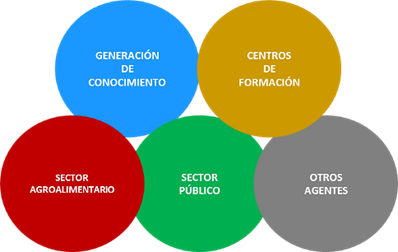Cantabria
Cantabria has a surface area of 5,321 km², of which more than 90% is considered rural. Within this area, 40% is used for farmland, which generates between 1.5 and 2% of the region's Gross Added Value (GAV).
Cantabria's agricultural holdings have an average area of 24.5 hectares. A large proportion of the cultivated hectares are rainfed, with a significant area devoted to forage crops and corn for animal feed. The Cantabrian livestock sector, which is the most important agricultural activity in the Community, is largely represented by cattle for the production of meat and milk ( European Commission (2024 ). In the Community's agro-industry, the cocoa, chocolate, and confectionery industries stand out, accounting for more than a third of the sector's turnover, followed by the dairy and fish industries. ( UNICAJA, (2021). The Agricultural Sector and the Food Industry in Spain: Main features and regional analysis in 2021 ).
The regional AKIS is represented by a cluster of public and private agents grouped together and interacting with each other:

The image shows the groups of public and private agents in a regional AKIS:
- Agents that generate knowledge.
- Public sector agents.
- Agents dedicated to training.
- Agents of the agri-food sector.
- Other AKIS agents.
AKIS agents and interactions
Agents dedicated to the generation of knowledge
- University of Cantabria .
- European University of the Atlantic .
- Agricultural Research and Training Center ( CIFA ): The Center develops research projects, experiments, and technological innovation to provide solutions to problems in the agricultural sector. Projects are grouped into four areas: Horticulture, Animal Food Quality, Animal Production Systems, and Socioeconomics.
- Institute of Environmental Hydraulics ( IHCantabria ): Joint research institute of the University of Cantabria and the Government of Cantabria focused on hydraulic research.
- Cantabria Technology Center ( CTC ): The Center's mission is to add value to companies through the application of practical and advanced solutions in the fields of industry and energy, navigation and robotics, and advanced materials and nanomaterials.
- Cantabria Industrial Research and Technology Center ( CITICAN ).
Public sector agents
- Ministry of Rural Development, Livestock, Fisheries and Food : public institution that administers the responsibilities of agriculture, livestock, agri-food, rural development and fisheries in the Autonomous Community.
- Regional Agricultural Offices (13):
Agents dedicated to training
- Agricultural and vocational training schools. A list of institutes and centers can be found here .
Agents of the agri-food sector
- Food Quality Office ( ODECA ), “Foods of Cantabria”.
- Agrocantabria AGC : Company born from the merger of six Cantabrian cooperatives.
- Professional Colleges of Agricultural Engineering , Agricultural Technicians and Veterinary Medicine .
- Professional Agricultural Organizations (OPAs): UGAM-COAG , ASAJA Cantabria , SDGM-UPA Cantabria , AIGAS-La Unión .
Other agents
- Society for the Development of Cantabria ( SODERCAN ): A public company of the Government of Cantabria whose mission is to promote and contribute to the creation of a socio-business environment that encourages investment in the business community and develops innovation and competitive improvement.
- Cantabrian Rural Development Network / Local Action Groups.
- Operational Groups .
Instruments and tools for the dynamization of the AKIS
REGIONAL SCIENCE, TECHNOLOGY AND INNOVATION STRATEGIES
For the period 2021-2027, the Research and Innovation Strategy for Smart Specialization of Cantabria (iCan 2020), led by the Ministry of Industry, Tourism, Innovation, Transport and Tourism, includes the bioeconomy and the agri-food sector as one of its 5 strategic ecosystems.
CAP 2023-2027
Within the CAP, Cantabria has budgeted €2.3 million for agricultural consulting and €850,000 for Operational Groups.
You can consult the details of the National Strategic Plan for the CAP-Cantabria by clicking here .
- Resolution of the Regional Minister of Rural Development, Livestock, Fisheries and Food, of July 29, 2025, calling for aid to agricultural associations for collaboration in the provision of advisory services that include technical and economic management, to agricultural holdings in the Autonomous Community of Cantabria for the year 2025
- Farm Advisory System of the Government of Cantabria



